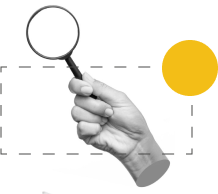Web App Security Assessment
Unleash our expertise on your web app's security. We'll uncover vulnerabilities, arm you with recommendations, and leave hackers with no chance. Let's join forces and show those vulnerabilities who's boss!


We have three types of WEB App testing in our arsenal:
DAST
Automated vulnerability assessment (with two scanners).

Quick
DAST: Going Beyond Automation for Accurate Vulnerability Assessment of your WEB application!
We take a hands-on approach to ensure precision:
- Our scanners receive personalized training to capture all critical functionalities while excluding irrelevant ones.
- To minimize false negatives, we conduct a thorough double-check by running a second scanner.
- Our final report combines insights from all scanners, complemented by our expert analysis, for a comprehensive evaluation.
Comprehensive pentest
According to OWASP WSTG.

optimal
WEB Application PENTEST
Our checks are in perfect sync with the OWASP WSTG framework, a gold standard of best practices trusted and embraced by penetration testers and organizations worldwide. We leave no vulnerability unexamined, ensuring your web application’s security is fortified against even the sneakiest threats.
Final Form
Full fledged application security verification to OWASP ASVS.

Comprehensive
WEB Application security assessment according to Application Security Verification Standard (ASVS)
If your web application requires the highest level of trust and unparalleled confidence in its security, the ASVS assessment is the perfect choice for you. It’s not an average penetration test—it’s like a full-blown security boot camp, covering every nook and cranny of your WEB application to ward off potential vulnerabilities.
For over 30 years, black box testing has revealed limitations in detecting critical security issues, leading to moments of “Oops! Missed that one!”. We replace traditional penetration tests with source code-led (hybrid) tests, and full access to developers throughout development. Our security tools, such as DAST and SAST, detect common issues, but human expertise is crucial for testing more that a half of ASVS controls.
Our expert team meticulously examines various aspects of your application, including architecture, design, configuration, authentication mechanisms, access controls, input validation, sanitization and encoding, error handling, and more. By adhering to ASVS, we leave no stone unturned in identifying and addressing security weaknesses.
Report structure
Management-Friendly Breakdown: Fear not, non-tech-savvy managers! Our report includes a concise description of each vulnerability using language that even the most "technologically challenged" can understand.
Technical Insight: Dive into a detailed technical description of all discovered vulnerabilities. We'll unveil their root causes, attack vectors, and potential impact on your system.
Testing Wizardry: Learn about the magical methods we employed to uncover vulnerabilities. From automated tools to manual testing techniques, we leave no stone unturned in our quest for robust security.
Tool Arsenal: Curious about the tools we wielded? Our report features a comprehensive list of the specific scanners, penetration testing tools, and other security assessment instruments we employed.
Risk Evaluation: Brace yourself for a risk assessment extravaganza! Each vulnerability is meticulously evaluated to help you understand its potential impact on your organization.
Mitigate and Conquer: We don't just point out problems; we offer solutions. Our report includes targeted recommendations for risk mitigation, covering everything from vulnerability elimination to implementing compensating controls and other savvy risk management strategies.
Expert Verdict: Wondering about the overall security status of your systems? Our report concludes with an expert opinion, highlighting strengths, weaknesses, and areas primed for improvement.
Team portfolio










Our certificates










Sometimes there are questions...
How long does a WEB APP penetration test typically take?
The duration of a WEB APP penetration test can range from one week to three weeks, but on average, it takes around 2 weeks. However, the exact timeframe depends on the complexity of the work. Feel free to reach out to us, and we will provide a more accurate estimation based on your specific requirements.
What factors have the most impact on the price of a WEB APP penetration test?
The pricing for a web application penetration test depends on several factors. These factors include the complexity and size of the application, the number of functionalities that need to be tested, and the depth of the testing required.
For example, a simple web application with a basic set of functionalities may have a lower price compared to a more complex application with advanced features and intricate architectures. Testing a basic blog or a static website will typically be less resource-intensive compared to a large-scale e-commerce platform or a banking system that handles sensitive financial transactions.
To provide you with an accurate quote, we take into account the specific characteristics and requirements of your web application. Our pricing is designed to be fair and transparent, ensuring that you receive a tailored and cost-effective solution that matches your unique needs.
Which methodology do we use?
- OWASP Web Security Testing Guide (https://owasp.org/www-project-web-security-testing-guide/) – Utilized for comprehensive penetration testing of WEB applications.
- OWASP Application Security Verification Standard (https://owasp.org/www-project-application-security-verification-standard/) – Utilized for a full-fledged auditing of WEB application.

What are the stages of the project?
- Sign the contract & NDA
- Approve the test plan and methodology.
- Start – passive information gathering and documentation study.
- Active reconnaissance.
- Identification of vulnerabilities (automated scanning and manual assessment).
- Verification of each vulnerability.
- Risk assessment, threat profiling, report writing.
- Report presentation.
- Re-verification after mitigating vulnerabilities.
How secure is the testing procedure for our environment?
Our goal isn’t to give your systems a bad day with a Denial of Service, but it’s important to understand that we actively attempt to push the systems beyond their usual functioning boundaries.
Now, if we’re venturing into the realm of production environments and dealing with critical systems, fear not! We have a bag of tricks to keep things in check:
- Risky business like vulnerability scanning and exploitation will only happen aftermutually agreeingwith you on the perfect timing. You can choose a maintenance window, for example, during weekends or nighttime, to minimize the risk for your customers.
- Manual checks will be handled with the grace of a tightrope walker, and our scanners willbe configured totiptoe around your systems like a ninja.
- We will establish an incident escalation procedure in coordination with you, ensuring that you are prepared to respond promptly if any incidents occur.It’s rare, but let’s face it, life is full of surprises.
- And don’t forget your system backups, always better to have them on standby.
Another option is testing in an environment identical to the production environment.
What tools do we use?
We utilize both paid and free tools for vulnerability scanning, research, and analysis. Additionally, we employ manual testing, search in public exploit and vulnerability databases.
- Web scanners: BurpSuite & Acunetix.
- Network scanners: Nexpose & Nessus.
- All tools included in the Kali Linux distribution, including Nmap and Metasploit.
- Exploits found in internet databases such as ExploitDatabase, CVE Details, 0day.today, as well as on GitHub.
- Mannually created tools and exploits.
Do you perform automated testing or manual testing?
Penetration testing is not just vulnerability scanning; a significant portion of the work is done manually. Vulnerability scanning provides input for manual checks, and the scanner is just one of the tools we use.
We also offer a separate service for vulnerability scanning, which is much simpler.
To reduce False-negatives during automated vulnerability assessment phase we double-check result with second scanner.
We appreciate your request.
Wait for the answer..
It will come.
I'll be waiting...














